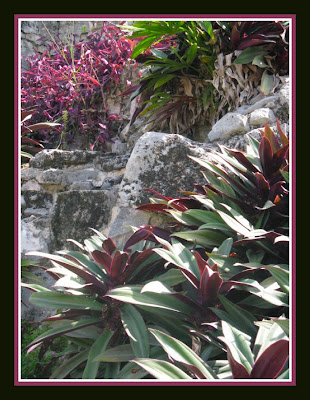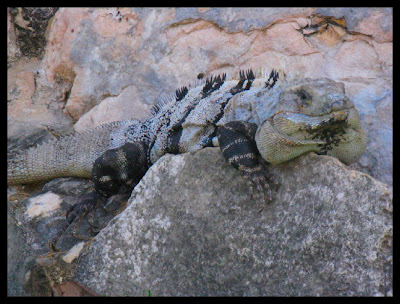Joanne and I had decided that while we were in Mexico our greatest task would be to do as little as possible – and we were very successful in accomplishing that goal! We spent most of our time staying at our resort enjoying the pools, beaches, restaurants and sunshine - with two afternoons visiting a nearby city. We did, however, spend one entire day visiting two very exciting places…
Since our journey to Mexico was possibly a once in a lifetime event, I wanted to do something interesting and artful while we were there. I thought that it would be fun to capture some video footage and create another music video.
Our one-day adventure was taking us to the ancient city Tulum. I was really hoping that it would be possible to climb up on one of the ruins to film the rising sun.
I found out that this would not be possible. Instead, Jo’ and I woke up very early and simply watched the morning sunrise from the beach at our resort.
After another wonderful breakfast, we hopped aboard a tour bus and were on our way.
These speed bumps from hell – LOL – are called ‘tope’. They are found on either end of any community existing along the only major highway through this region. Vehicles turn on their 4-way blinkers and come to a dead stop before easing over these solid metal bumps. Great for traffic speed control in urban areas.
Although the architectural designs for residential living are quite different from those found in Canada, one aspect is the same – Urban Sprawl!
Along the highway I saw many billboards advertising luxury homes in condo style developments. I hate subdivision sprawl in Canada and I was saddened to see this style of development here. When will our urban planners realize that communities built upon the NEED for automobiles are destined to increase our destructive relationship with our Earth?
Beside the roadside billboard a roadway is cut into the jungle so that huge machines can clear away the non-profitable trees and swamplands in order to build happy homes with streets named after the kinds of trees that used to populate the area for thousands of years! Hmmmm… where have I heard that story before?
Our busride took us over one bridge. From here it became very clear just how flat this region of Mexico is. The entire area is wild jungle, stretching out and out… but not for long if urban developers have their way.
I asked our tour guide why the trees in these jungles are so short. I never saw a tree trunk larger than a foot and a half in diameter and for a while I was thinking that this region may have already been clear-cut and that I was looking at young trees that had been recently planted. The guide told me that these jungles were indeed very old and the reason why the trees were so short is because there is very little topsoil and very little rain. This region experiences great amounts of rain during certain times of the year but most of it washes into the ocean, again, because of the lack of topsoil.
The busride was just over an hour long and then suddenly we found ourselves taking a step back in time.
Our tour guide told us many stories and as I listened I found my imagination wandering, wondering what life must have been like for the people of this region and time. We learned that the proper name for this city was Zama – meaning The City of Dawn. Justly named for an area on the most easterly part of this country, bordered by a great ocean.
When the Spanish came to this area they pointed to the great wall which surrounded the inner city and asked what it was called. The Spanish were referring to the city but the Mayans thought they were referring to the wall which is named Tulum. This word stuck and now this city is called Tulum.
We learned about the social order of the Mayans. The nobles, elitists and religious leaders lived within the wall. The tradesmen and workers lived outside the wall. Their homes were made of trees, fronds and clays and so after this area was abandoned the Earth quickly reclaimed its own, leaving only the sacred buildings which were constructed using more durable materials.
The Mayans lived in reverence of the beauty and power of Nature. We learned about how they gathered most of their food while domesticating a few species, which were farmed. They had to adapt to the many different elemental seasons of this region, as did these termites. During the rainy season much of the land becomes flooded. That is why these termites build their nests in tree branches.
It was interesting to learn that bubble gum came from the Mayans. Our guide pointed out the trees which the Mayans would ‘tap’ – like how we tap maple trees for syrup – to get a chewy snack. The Spanish invaders added a little sugar and flavour, and bubble gum was invented.
We learned that this was one of the last places to be reached by the Spanish. Just off of the coast there is a great and long reef which follows the coastline. The large European ships could not get to shore so they had to dock many miles away and hoof it on foot to these cities. This gave the Mayans the time they needed to abandon their cities so they wouldn’t become slaves. It is estimated that over one million Mayans still live throughout Mexico.
The reefs that saved them from brutal attacks did have small valleys in them. The Mayans knew where they were and this allowed them to travel from village to village or city in smaller boats for trading.
The Mayans were great mathematicians – following the standards of time as laid down by universal occurrences. They constructed temples that would have small holes cut into them. During the summer equinox the morning sun would shine through these holes and onto other religious structures.
Other buildings had different holes and at different times of the year the sun would shine through these to tell the Mayans that it was time to plant or harvest a certain crop.
Of course, someone (and it wasn’t me) had to ask about the Mayan calendar ending on the winter equinox in 2012. We learned that the Mayan calendar, just like ours, has a beginning and an end. When our calendar ends on December 31, we simply begin our cycle again for the new year. The Mayan calendar is the same, however, their cycles last for over 5 000 years.
Our guide used a stick to explain this by drawing in the sand. He drew one circle and began dividing it, explaining how it relates to the stars – just like our zodiac. The Mayans used this to mark the years – very much like our calendar. Then he drew another circle, touching the first one and explained how this one was divided differently – in nine parts – to honour the timing of the birthing process. Then he added two other circles, one on each end of his drawing. These circles represent Venus and Mars and based on their solar alignment with the Earth, another cycle of their calendar is represented.
So… instead of living in fear that the Mayan calendar is ending we should be living with great expectation to witness a massive solar occurrence that will not happen again for over another 5 000 years! It’s impossible to know for sure, but the alignment of three planets is sure to have many interesting consequences (maybe the ocean tides will rise an extra ¼ inch on some of our coastlines – I don’t know), but I’m sure that we will not witness what many fantasy dreamers are living in fear (or possibly celebration) of.
Our second destination of the day was the coastal inlet of Xel-Ha.
 There were many activities to keep people of all ages amused. Joanne and I spent over four hours snorkeling in the warm and fish filled waters.
There were many activities to keep people of all ages amused. Joanne and I spent over four hours snorkeling in the warm and fish filled waters.
Many of the T-shirts found in the shops were promoting ‘green’ philosophies, expressing our needs to tread lightly on the Earth so that we can preserve our environments for future generations. Since Xel-Ha is a water resort – of sorts – I laughed when I saw T-shirts with dolphins and fish with sayings like, “BLUE is the new green”.
We had to use special ‘enviro’ sunscreens at Xel-Ha, to protect the water and fish. It costs about the same as normal sunscreen and this made me wonder why it hasn’t become a standard for all sunscreen manufacturers around the world.
Joanne and I both agreed that our adventures on this day were the height of our entire vacation. We had an absolute blast!!!
By the time we got back to our resort the sun had set and our bellies were complaining. It wasn’t long after another great dinner when we found ourselves sitting by the pool with very heavy eyes.
We continued enjoying ourselves for the next several days and then it was time to come home. Home to the cold…
… and snow that is Canada!
Ahhhhh! It was great while it lasted!!!
Jim



























No comments:
Post a Comment